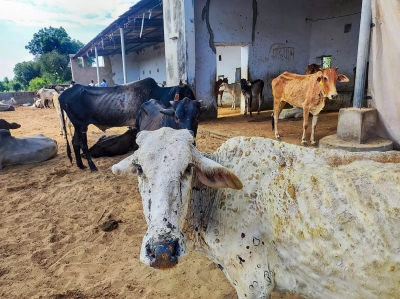
Many States are grappling with the problem of Lumpy Skin Disease (LSD) in cattle. The disease poses a serious threat to the dairy sector. Thousands of cattle have died since July due to LSD in different parts of the country, including Gujarat, Rajasthan, Punjab and Haryana. The Centre, along with States, is making efforts to control the disease. But what is Lumpy Skin Disease or LSD? Come, let’s find out.
Contagious viral disease
LSD is a contagious viral disease that affects cattle. Detected only in cows and buffaloes, LSD causes high fever, reduced milk yield, large nodules on the skin, and loss of appetite. It affects the lymph nodes of animals, causing the nodes to enlarge which appear aslumps on the body, and hence the name. With the progression of the disease, the nodules rupture, resulting in the animals bleeding. LSD also causes discharge from the nose and eyes andexcessive salivation. It can also lead to the death of the cattle. Brought on by capripoxvirus, it is transmitted by blood-feeding insects such as certain species of flies, ticks, and mosquitoes. The disease can also spread through contaminated fodder and water. LSD currently has no known treatment; instead, only clinical symptoms are treated.
Not transmissible to humans
As it is not a zoonotic disease, LSD is not transmissible from cattle to humans. It is said that there is no danger to humans in consuming milk of affected animals. According to reports, a senior official at Indian
Veterinary Research Institute (IVRI), said, “It is safe to consume milk from the infected cattle. There is no problem in the quality of milk even if you have it after boiling or without boiling.”
Vaccine for LSD
The disease was first observed in Zambia in 1929 and later spread to many other African countries. It first surfaced in India in 2019. Ever since, research institutes have been engaged in developing a vaccine for LSD. The recent outbreak was in
June this year. The indigenous vaccine named Lumpi-ProVac was launched by the Ministry of Agriculture and Farmers Welfare in August 2022 to protect livestock from the disease. The vaccine has been developed by the scientists of two Indian Council of Agriculture Research (ICAR) institutes (National Equine Research Center, Hisar, and Indian Veterinary Research Institute, Izzatnagar). It is expected to become commercially available at the earliest.
Since the disease in cattle impacts milk production, affecting dairy farmers and their income, the government is focussing on universal vaccination of livestock. At present, cattle are being inoculated with goat pox vaccine, which is found to be effective against LSD.
Picture Credit :Google




